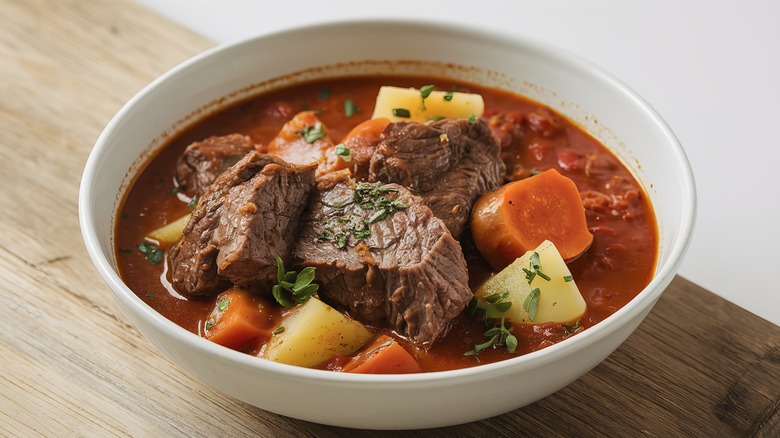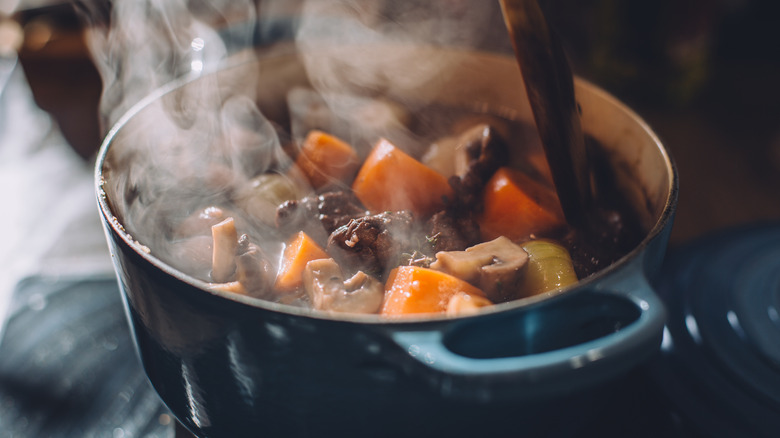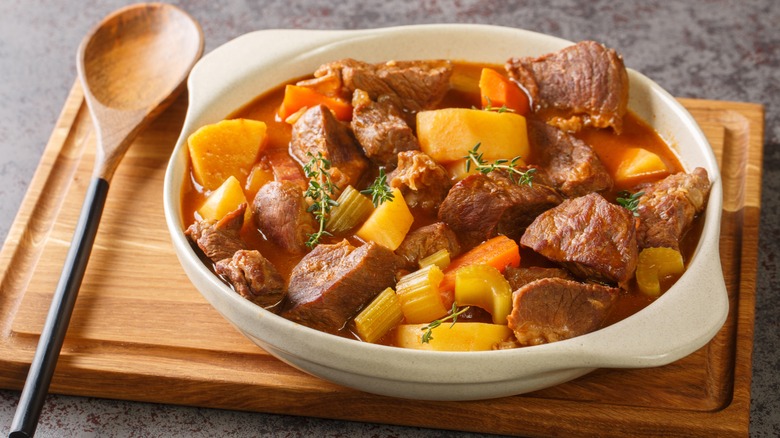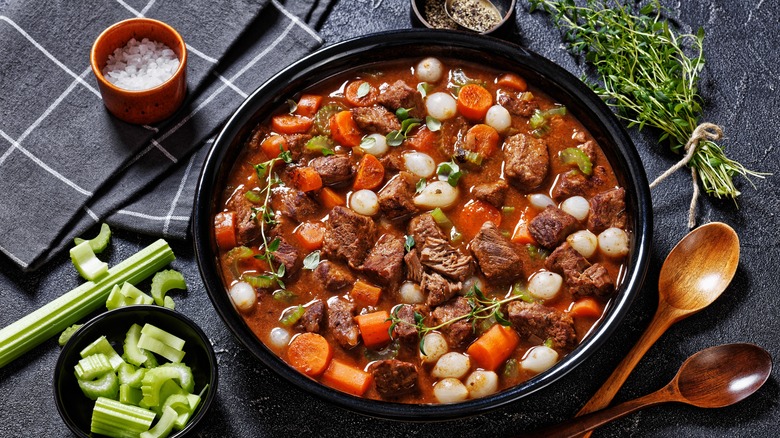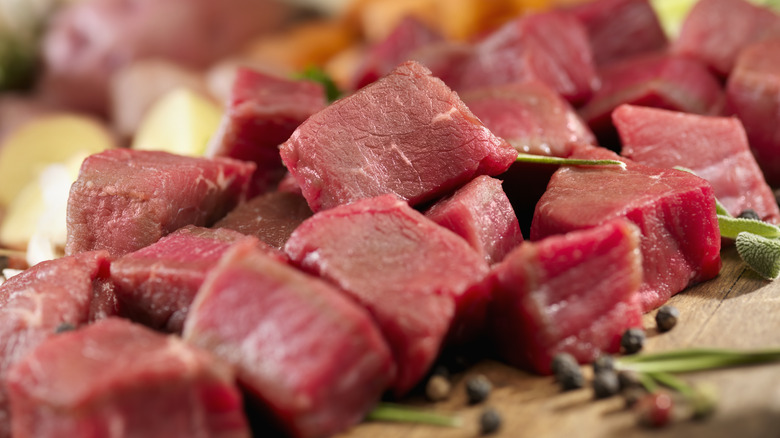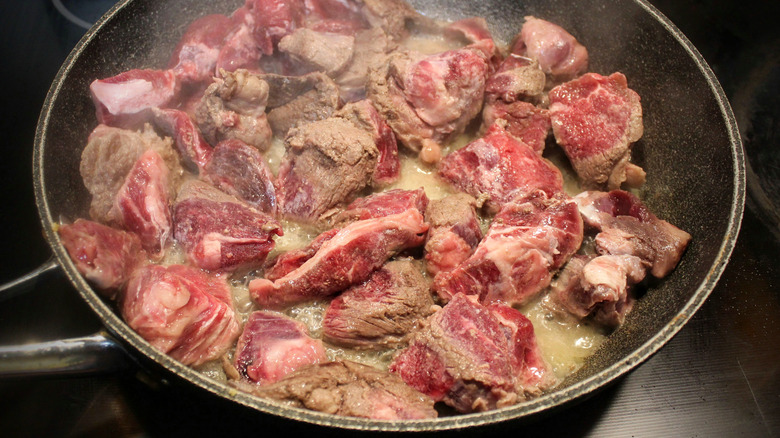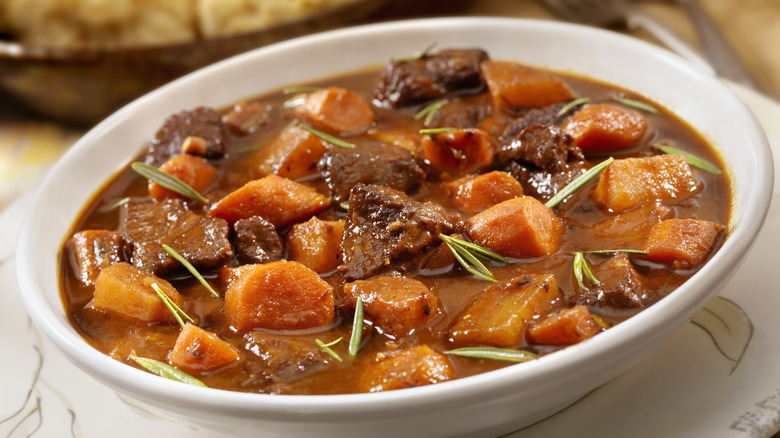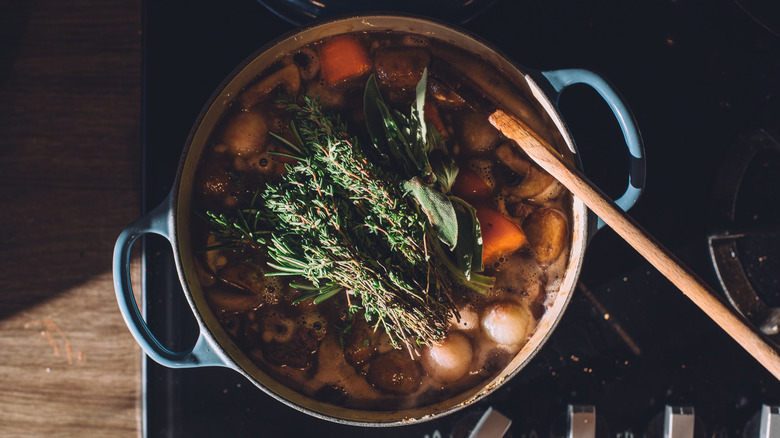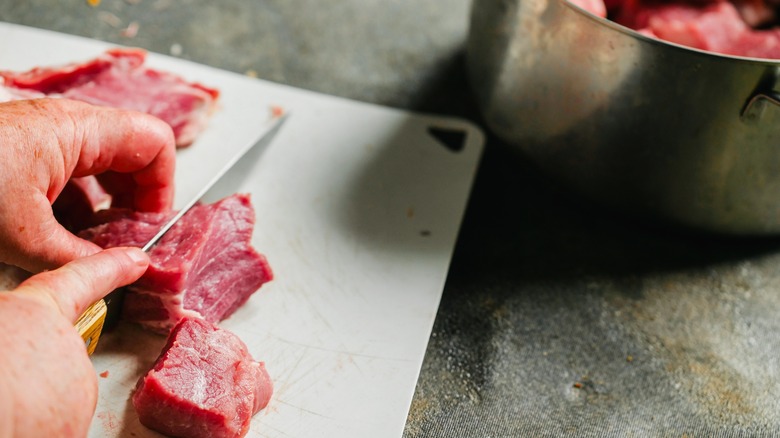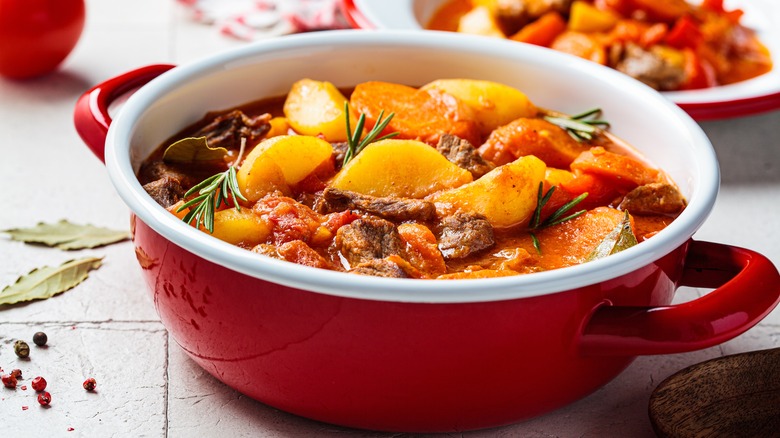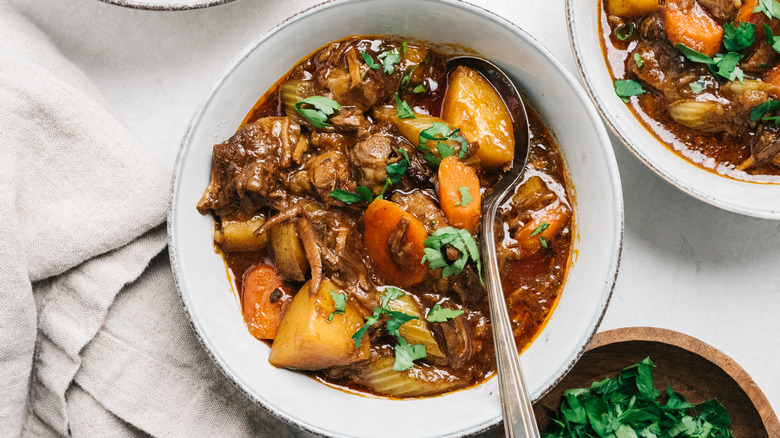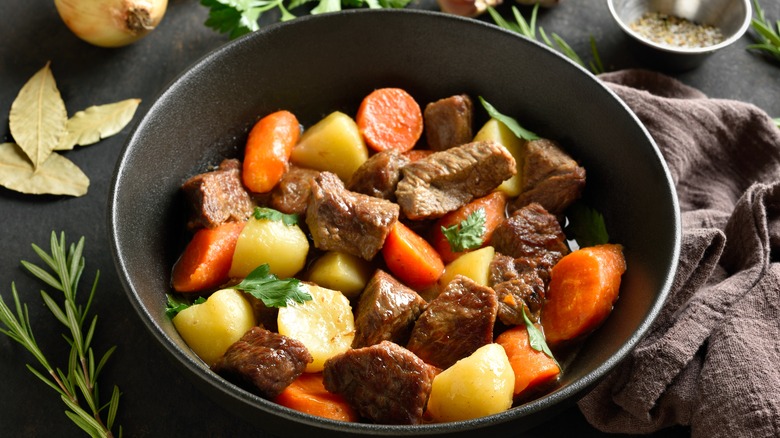Mistakes To Avoid When Cooking Beef Stew
We may receive a commission on purchases made from links.
Beef stew might be an easy, versatile one-pot meal but the best versions follow a few key rules. It might not be difficult to prepare, but we can bet that you'll know right away if your dish was a success or a flop by relying on taste and texture. This comfort meal is typically a combination of tender beef and vegetable like carrots and potatoes, plus a flavorful broth that gets its richness from beef broth, beer, or wine. If you find that your stew isn't turning out the way you expected, you may be making one of these mistakes. From adding ingredients in the wrong order to not letting the stew actually stew, these are the top mistakes that professional chefs, recipe developers, and beef experts see when it comes to making this delicious dish.
Fortunately, our experts have tips to turn your stew around. They shared their favorite combinations of flavors as well as tricks to getting the beef perfectly tender to form the ideal base for a hearty stew without ending up with mushy, inedible vegetables. Avoid these mistakes and you'll be enjoying a bowl of your own beef stew in no time. All you need to add is some crusty bread to soak up every last delicious bite.
Using the wrong tools
Even though beef stew is pretty simple and you doesn't require a lot of technical know-how, using the right cookware is important to get the best results. A cast iron dutch oven works wonderfully for beef stew because it can hold a lot of ingredients and evenly heats everything from broth to beef to veggies. Cast iron also works to brown the meat ahead of adding the other ingredients, turning this dish into a one-pot meal that you can whip up without creating a massive stack of dishes.
"I've tried everything else...from a crockpot to an instant pot...to a plain old stock pot," said Debi Morgan from Quiche My Grits. "But, nothing holds the heat and produces a constant temperature like an enameled dutch oven. It truly makes a difference in the tenderness of the meat, and creates a delicious beef stew every time." As a chef specializing in Southern cooking, Morgan knows a thing or two about comfort food.
The ideal Dutch oven size depends on how much stew you are making, but look for one that can hold all of your ingredients, plenty of broth, and still have room to stir. The last thing that you want is to overfill your pot so that you can't mix everything together, another essential step for even cooking. If you're making a big batch to freeze some for later, you'll need an oversized stock pot of large Dutch oven.
Adding ingredients too soon
One of the biggest mistakes that people make with beef stew, especially when they are in a hurry, is to throw everything into the pot at once and hope for the best. While you might think that it doesn't matter since everything gets cooked together, but rushing the ingredients into the stew doesn't let each of them cook for the right amount of time. This spells disaster for this slow-cooked dish, which needs some time to build up in order to get the best taste and texture in the end.
Debi Morgan learned the trick to tender beef from her mother and now uses it in her own stew recipes. "If you get impatient and add other veggies to the pot too soon, it can cause the meat to be tough," she said. "I simmer the beef in beef broth (or dark beer depending on the recipe) for at least one hour per pound until it's melt-in-your-mouth tender. Then, I add carrots and potatoes and cook them until they're done, which is usually about one hour depending on the quantity."
Letting the beef start cooking first is important for flavor as well as texture. If you pile a ton of vegetables into the pot too early, it can be difficult to get the meat browned completely. Fortunately, giving the meat time to brown and turning it evenly for even just a few minutes over high heat is enough to get the delicious crust that you want.
Choosing the wrong cut
Even though beef is one of the main ingredients in beef stew, many people choose the wrong cut or don't even know what cut they're using. When making this dish, look for a cost-effective cut that has some fat to add flavor. You can get precut stew meat, which is ready right out of the package, or buy a larger roast and trim it yourself. Chuck roast and bottom round are good options that are budget-friendly and easy to work with in stew recipes. Both have enough fat to add flavor but are lean enough to keep the stew from getting too greasy. They can also be cut into bite-sized pieces and browned before you add broth and vegetables. A chuck steak and chuck roast can be used interchangeably, since both come from the same part of the cow, although you'll need a few steaks to get enough meat.
Short ribs also work and add richness thanks to the bone-in cut. Dagan Lynn, executive chef at National Cattlemen's Beef Association, recommends using short ribs when making stew in the slow cooker. "Short ribs will result in a tender fall-off-the-bone meat that is perfect for stews," he says. "Plus, this bone-in-cut helps to add extra flavor from the marrow."
Not cutting it into cubes
Good stew is hearty but can still be eaten easily with a spoon. While larger pieces of meat are generally good when it comes to steak, for stew you might need to trim or cut a bigger roast to get the best results. Beef stew works best with bite-sized portions of meat in the stew, which not only cook faster, but meld better with the other ingredients. Chef Dagan Lynn recommends 1-inch cubes to ensure that you always get a taste of beef when you're enjoying your finished dish. After all, what's beef stew without actual beef in each bite? It's best to avoid cutting your stew meat any smaller, however, since you want to maintain enough texture to get the robustness of the dish.
When cutting your meat, make sure that the pieces are roughly the same size. Uniformly-sized pieces ensure that they all cook evenly and you're not left with undercooked or overcooked bites in the same batch. Smaller pieces mean more surface area for browning, which adds flavor to the dish. Base your rough chopped vegetables off of the size of your stew meat as well. Ideally, they will be of similar size, although tender veggies can begin to crumble if they stew for too long.
Not browning your meat
One of the most impactful flavor mistakes that people make is to add liquid and start stewing right away. Before you add anything else to your pot, brown the outside of the beef. This brings in a crispy texture, which is more pronounced on larger pieces of beef, as well as a lot of savory flavor. Season the outside with simple salt and pepper to bring out this taste even more. Chef Dagan Lynn recommends browning over medium high heat. Use oil with a high smoke point to prevent it from burning while it heats.
Browning the meat adds flavor and texture thanks to the Maillard reaction. "This step is key to locking in more complex flavors, and the caramelization enhances the appetizing color of the stew," says Karen Tedesco with Familystyle Food. While the Maillard reaction and caramelization are not the exact same chemical reaction, both help to bring out flavors of ingredients when cooked over heat. The proteins in meat react with the high heat to create a browning effect, which adds savory flavor as well as that intensely rich aroma that makes our mouths water.
Using too little liquid
Make sure that you cover all of your ingredients with liquid, especially if you're making beef stew in the slow cooker. You can add broth, beer, or other ingredients to develop a complex flavor. V8 is an unexpected addition that adds extra flavor and acidity to the dish. Another great option is to use Italian dressing, which has oil, vinegar, and spices already incorporated. You'll need a strong base, typically from broth, to hold up to its bold flavors, but it can be a great way to add flavor on a budget.
The right amount of liquid required depends on everything that's going into your stew and not just the beef itself. "Think vegetables and liquids (beef broth, wine, beer, water, etc.)," says Dagan Lynn. "Make sure all of your ingredients are covered in the liquid."
Debi Morgan likes to add just a single onion along with the beef broth as she simmers the meat before loading up the stew with additional ingredients. This lets the meat get extra tender, although that also means you may need to add more liquid later in the cooking process. Don't be afraid to adjust as you go to keep the liquid above the level of the beef, veggies, spices, and other additions.
Lifting the lid
Chef Dagan Lynn says that one of the biggest mistakes people make is to not "stew the stew." You have to let it cook to get the most tender and flavorful results. This means getting it to simmer and letting it be. If you lift the lid and check on it too often, it will interfere with the cooking process. Not only does this affect the temperature of the stew in the pot, it can also let out steam, which is needed to make sure that all of the vegetables are tender. The best thing to do is simply put the lid on the stew and walk away for a couple of hours.
You can check the beef with a fork to see if the stew it done. The same technique works for vegetables in the stew as well. Once you're able to pierce it with a fork, the dish is ready to ladle into a bowl and enjoy. Compared to pot roast, which cooks in the oven, beef stew is a bit easier to keep track of since it simmers on the stovetop. A stock pot with a clear lid lets you peek in without having to actually lift the lid.
Buying unknown stew meat
It seems obvious that the packages of meat labeled as stew meat would be the ideal choice at the store. However, these are typically packaged with leftovers from other orders, cut into uniform pieces to be more appealing and reduce waste for the butcher.
You might also think that getting stew meat already cut would save time, but sometimes, you end up getting meat that you're not quite sure how to prepare. If it is a mix of various cuts, all of which cook differently, some will dry out or get tough while others are much more tender. The result is a stew with varying textures rather than a melt-in-your-mouth bite of beef. If you have to decipher this mystery meat, it can take longer in the end and the results are less likely to have the delectable texture that you want.
For the best results, buy a larger chuck roast and cut it yourself at home. "To make a stew with fork-tender meat, it's best to buy a 3 to 4-pound piece of boneless beef chuck roast, and trim it at home," says Karen Tedesco. Of course, the exception to this is when butcher counters label their stew meat with the type of beef used. This is more common at specialty butcher shops. Some stores will also cut to order, allowing you to work with the butcher to determine the best part of the cow and size of the stew meat for your recipe.
Cutting pieces too small
While it's important to cut larger pieces of beef into bite-sized chunks, you don't want to go too small or you'll risk the tender texture of your dish. Stew meat that is too small tends to dry out, even though you need time for the flavors to meld. Karen Tedesco recommends choosing beef with good marbling and cutting them 3-4 inches in diameter for flavorful and tender beef. As you braise the beef, the fat melts, adding flavor to the dish and keeping the beef extra tender.
Chef Dagan Lynn aims for a 1-inch piece when he's getting ready to put stew into bowls. He prefers smaller pieces so that every spoonful has a good mixture of all of the ingredients, including beef and vegetables.
When browning your beef, larger pieces take up more space at the bottom of the Dutch oven, while smaller pieces can fit together with less space. You may need to use a tongs to turn large chunks to sear each side, but smaller pieces can be rotated with a spatula or spoon.
Adding vegetables too early
One of the biggest mistakes that people make is to put all of the vegetables in with the beef right away. Not only does this prevent the beef from getting tender, it can result in mushy vegetables that spend too long in the stew. Instead, add them from the ground up after you've browned the meat. Start with those veggies that grow in the ground, including carrots and potatoes. Add above-ground produce, including celery and peppers, which take less time to cook.
Jennifer Borchardt, Culinary Director for Pre Brands, recommends approaching your stew in two steps. She puts vegetables in with the stew as it cooks to add flavor, then removes them and adds a fresh batch later. "The first veggies you use can be blended down for a different soup base to avoid waste and the veggies you put in halfway will be perfectly cooked by the time your stew is done," she says. This avoids the dreaded mush that comes with overcooked vegetables.
The only exception to this rule is when you want to thicken the stew using a vegetable slurry. Rather than adding a flour-based roux, mash some of the extra tender veggies, such as potatoes and carrots, along with broth. When added back into the stew, this mixture helps to make it thicker and more substantial. It is a useful trick if you find that your stew is closer to a vegetable beef soup and you want it to be heartier.
Skipping the simmering
It can be tempting to serve up your beef stew as soon as all of the ingredients are cooked through, but the best recipes simmer for at least a couple of hours. This allows the flavors to blend together and ensures the beef is super tender. Even though the beef might be cooked all the way through, it still needs time to simmer in the stew for the best texture. This breaks down tough collagen in the meat and gets super tender bites.
Add seasoning and spices, including fresh herbs, to the stew early in the cooking process to let them impact the taste of all of the ingredients as they cook. While the stew is simmering, resist the temptation to check on it too often. Just turn the heat down and let it do its thing. It can be helpful to sample the stew periodically, but keep your tasting to just a spoonful and put the lid back on the pot quickly.
Debi Morgan makes sure that the temperature remains constant as the beef simmers for at least an hour before she adds vegetables to the pot. The meat requires the longest time in the stew, but you can add salt and pepper seasoning plus herbs to give it a boost of flavor even at this early step. It's also important to make sure there is enough liquid to cover the beef as it simmers.
